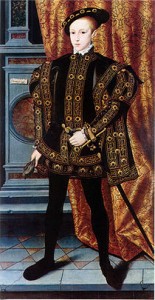 On this day in 1553, King Edward VI was buried in a white marble vault beneath the altar of Henry VII’s Lady Chapel in Westminster Abbey. Merchant-taylor Henry Machyn recorded the funeral procession in his diary:
On this day in 1553, King Edward VI was buried in a white marble vault beneath the altar of Henry VII’s Lady Chapel in Westminster Abbey. Merchant-taylor Henry Machyn recorded the funeral procession in his diary:
“The viij day of August was bered the nobull kyng Edward the vj, and vij yere of ys rayne; and at ys bere[ing was] the grettest mone mad for hym of ys deth [as ever] was hard or sene, boyth of all sorts of pepull, wepyng and lamentyng; and furst of alle whent a grett company of chylderyn in ther surples, and clarkes syngyng, and then ys father(‘s) bedmen, and then ij harolds, and then a standard with a dragon, and then a grett nombur of ys servants in blake, and then anodur standard with a whyt greyhond, and then after a grett nombur of ys of[ficers,] and after them comys mo harolds, and then a standard with the hed offesars of ys howse; and then harolds, Norey bare the elmett and the crest on horsbake, and then ys grett baner of armes in-brobery, and with dyvers odur baners, and then cam rydyng maister Clarensshuws with ys target, with ys garter, and ys sword, gorgyusly and ryche, and after Garter with ys cotte armur in brodery, and then mor [harolds] of armes; and then cam the charett with grett horsses trapyd with velvet to the grond, and hevere horse havyng [a man] on ys bake in blake, and ever on beyryng a banar-roll [of] dyvers kynges armes, and with schochyon(s) on ther horses, and then the charett kovered with cloth of gold, and on the [charett] lay on a pycture lyeng recheussly with a crown of gold, and a grett coler, and ys septur in ys hand, lyheng in ys robes [and the garter about his leg, and a coat in embroidery of gold; about the corps were borne four banners, a banner of the order, another of the red rose, another of queen Jane (Seymour), another of the queen’s mother. After him went a goodly horse, covered with cloth of gold unto the ground, and the master of the horse, with a man of arms in armour, which] was offered, boyth the man and the horsse. [There was set up a go]odly hersse in Westmynster abbay with banar [-rolls] and pensells, and honge with velvet a-bowt.”1
The funeral service was performed by Thomas Cranmer, in keeping with Edward VI’s Protestant faith, so Mary I did not attend and, instead, had requiem masses sung at the Tower of London for three days beginning on 8th August at Vespers.2 3 Edward VI’s funeral was the first monarch’s funeral to follow the Protestant rites from the Book of Common Prayer.
Edward’s grave was unmarked until 1966 but his coffin was seen in the 19th century and it was labelled with a Latin inscription which, when translated, read:
“Edward the sixth by the Grace of God King of England, France and Ireland, Defender of the Faith and on earth under Christ supreme head of the churches of England and Ireland and he migrated from this life on the 6th day of July in the evening at the 8th hour in the year of our Lord 1553 and in the 7th year of his reign and in the 16th year of his age.”4
In 1966, a stone was placed in front of the altar of the chapel, marking his burial site and inscribed with the following memorial:
“IN MEMORY OF KING EDWARD VI BURIED IN THIS CHAPEL THIS STONE WAS PLACED HERE BY CHRIST’S HOSPITAL IN THANKSGIVING FOR THEIR FOUNDER 7 OCTOBER 1966.”5
You can see a photo of the stone at www.westminster-abbey.org/our-history/royals/burials/edward-vi
Also on this day in history…
- 1503 – The formal wedding of Margaret Tudor and James IV of Scotland in the chapel of Holyroodhouse. The couple had been married by proxy on 15th January 1503 with Patrick Hepburn, the Earl of Bothwell and Lord High Admiral of Scotland, standing in for James. Bothwell was the great-grandfather of James Hepburn, 4th Earl of Bothwell, husband of Mary, Queen of Scots.
- 1588 – Elizabeth I decided to accept the Earl of Leicester’s invitation and visit the troops he had gathered near Tilbury Fort to defend England against the forces of the Spanish Armada.
Notes and Sources
- ed. Nichols, J.G. (1848) The Diary of Henry Machyn: Citizen and Merchant-Taylor of London (1550-1563), p 34-50, which can be read online at www.british-history.ac.uk/report.aspx?compid=45512
- The Ambassadors in England to the Emperor, 2nd August 1553, Calendar of State Papers, Spain, Volume 11: 1553, p127-150
- The Ambassadors in England to the Emperor, 8th August 1553, Calendar of State Papers, Spain, Volume 11: 1553, p150-162
- http://www.westminster-abbey.org/our-history/royals/burials/edward-vi
- Ibid.